R.J. Stowell's Blog: rjsomeone, page 85
March 2, 2018
Trout Mask Replica
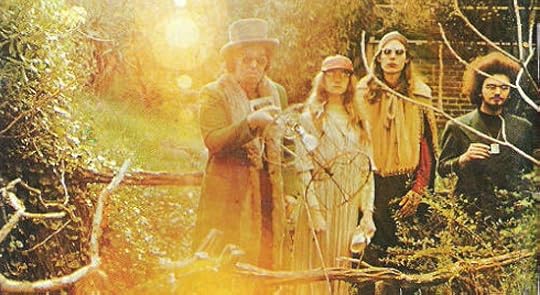 The circumstances surrounding the recording of Captain Beefheart & His Magic Band's third album, Trout Mask Replica, were about as hellish and unbelievable as one could imagine. Captain Beefheart himself (AKA Don Van Vliet), a self-described paranoid schizophrenic, essentially held the band hostage as they learned and recorded the songs that would make it onto the record. But for a little context, let’s rewind.
The circumstances surrounding the recording of Captain Beefheart & His Magic Band's third album, Trout Mask Replica, were about as hellish and unbelievable as one could imagine. Captain Beefheart himself (AKA Don Van Vliet), a self-described paranoid schizophrenic, essentially held the band hostage as they learned and recorded the songs that would make it onto the record. But for a little context, let’s rewind.The band’s first single, a cover of Bo Diddley's "Diddy Wah Diddy," was released by A&M in March 1966, but after it and a subsequent single failed to find commercial success, the label dropped the band. Buddah Records picked up the band and released the debut LP, Safe As Milk, -and while the album found a measure of critical and commercial success, the label quickly became known for artists specializing in "bubblegum pop."
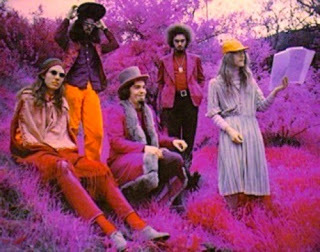 After a few independent studio sessions, the bulk of which would become the "Strictly Personal" and "Mirror Man" records, it fell to Van Vliet's childhood friend and über-musician Frank Zappa to help realize the Magic Band's musical potential. It was around this time that Zappa had started a pair of record labels (Bizarre Records and Straight Records) and offered the band an opportunity to record with total artistic freedom. The resulting sessions produced the songs that would make up Trout Mask Replica.
After a few independent studio sessions, the bulk of which would become the "Strictly Personal" and "Mirror Man" records, it fell to Van Vliet's childhood friend and über-musician Frank Zappa to help realize the Magic Band's musical potential. It was around this time that Zappa had started a pair of record labels (Bizarre Records and Straight Records) and offered the band an opportunity to record with total artistic freedom. The resulting sessions produced the songs that would make up Trout Mask Replica.In 1968, while spending most of their time among the enclave at Zappa's house in the Canyon, the band rented a small house in Woodland Hills, a Valley suburb of Los Angeles. Van Vliet began asserting his creative and emotional dominance over the band immediately, including sessions of lengthy verbal abuse and, according to the band, physical violence. The whole situation was described by drummer John French as having a "cultlike" atmosphere; indeed, the atmosphere has often been called "Manson-esque."
Drugs, of course, were everywhere, with LSD the usual drug of choice, no doubt fuelling Beefheart's purported belief that the house was built on the site of Native American burial ground and that he could communicate with their spirits.
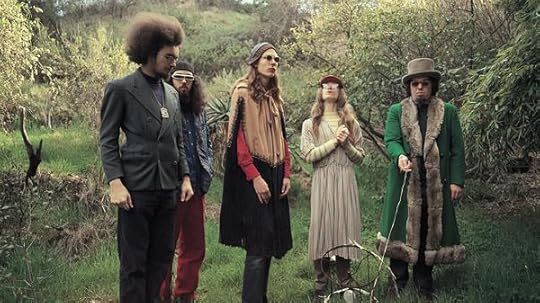
Beefheart persuaded the band that women and sex would interfere with the music and so the band just played and played. Then there were the "brainwashing" sessions, fist fights that broke out in the fractious atmosphere. There was no money to speak of and they starved, were struck down with illnesses and could often be found wandering around looking for food, in one report a band member aimlessly meandering about the wealthy neighborhood in a dress, army boots and a helmet, a crazed look in his eyes. Duh. Hunger and LSD will do that.
Eventually they all would leave at one point or another, but most came back for food and to recuperate. The group even got arrested once after a shoplifting spree because they had no money to buy food and had to get Zappa to bail them out.
Call it what you will, the music the band produced was fractured, awe-inspiring and often downright bizarre. Working from within a confluence of genres, including folk, jazz, rock and blues, the band became the model for rhythmic experimentation. The album is often difficult to listen to – no, it’s always difficult to listen to. As an example, the two guitar leads on the opening track "Frownland" are playing in different time signatures – one in 5/4 time, the other in 7/4 time. Meanwhile the bass acts as a third guitar, but unusually playing chords; and that's not thirty seconds into the track.
Several songs incorporated brief sections of other songs, such as Gene Autry's recording of "Rancho Grande" being used as one of the guitar parts in "Veteran’s Day Poppy." Other examples included the use of Steve Reich's "Come Out" as inspiration for "Moonlight on Vermont" and the Miles Davis-cribbing "Sugar 'n' Spikes," which took a melodic turn from Davis' recording of "Concierto de Aranjuez." But these influences weren’t wholesale mimicry; the band twisted and reformed the sounds into something completely new and uniquepaying homage to their source material.
Again, Trout Mask Replica is no easy listen. It's a sprawling double album of surrealist jazz, deranged delta blues like Charlie Patton and Skip James as well as apparently nonsense lyrics amidst jarring chords that leave the listener frazzled and disoriented.
Just what, for instance, can one make of "Neon Meate Dream of an Octafish?"
Speckled speculation Fedlocks waddlin’ feast Archaic faces frenzy Ceramic fists artificial deceased ‘n cists rancid buds burst
It is indeed, for my goodreads friends, purely Joycian.
Trout Mask Replica is utterly compelling, drawing one into its world. It gives no quarter, no compromise. The idiosyncratic vision is pasted across all 28 songs, forming one of the most comprehensive and enduring musical visions in rock.
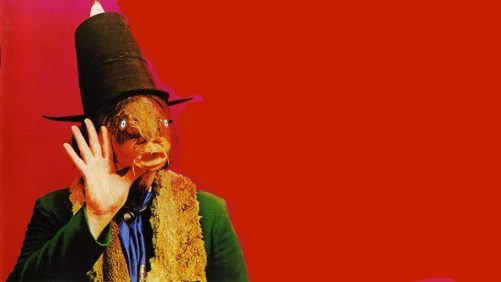
Tom Waits: "Beefheart was the roughest diamond in the mine... enter the strange matrix of his mind, and lose yours."
Published on March 02, 2018 04:41
March 1, 2018
Pamela Miller
 Our mini series on rock muses ends here (at least temporaily – although it could go on endlessly) with Pamela Miller (Miss Pamela), who grew up in Southern California and, as a teenager in one of the great eras to be a teenager (she was 15 when The Beatles were on Ed Sullivan), she went to Cleveland High School with Miss Sparky (Linda Sue Parker) who introducedher to Captain Beefheart, Don Van Vliet) which resulted in her meeting, dating, fucking, Mick Jagger, Jimmy Page, Keith Moon, Waylon Jennings, Chris Hillman, Noel Redding, Jim Morrison (and a bevy of others) and was close friends with Frank Zappa, Robert Plant, Gram Parsons and Ray Davies. (Yes, that is one long sentence; now saw it without taking a breath.
Our mini series on rock muses ends here (at least temporaily – although it could go on endlessly) with Pamela Miller (Miss Pamela), who grew up in Southern California and, as a teenager in one of the great eras to be a teenager (she was 15 when The Beatles were on Ed Sullivan), she went to Cleveland High School with Miss Sparky (Linda Sue Parker) who introducedher to Captain Beefheart, Don Van Vliet) which resulted in her meeting, dating, fucking, Mick Jagger, Jimmy Page, Keith Moon, Waylon Jennings, Chris Hillman, Noel Redding, Jim Morrison (and a bevy of others) and was close friends with Frank Zappa, Robert Plant, Gram Parsons and Ray Davies. (Yes, that is one long sentence; now saw it without taking a breath.[image error]She became the live-in nanny for Frank Zappa's oldest children, Dweezil and Moon Unit during the late 1960s, and after a few years, she was a member of one of the first all-girl rock groups, created by Zappa, the GTOs – Girls Together Outrageously. "Zappa was my mentor," she said. "He brought out in me all sorts of creativity I didn’t know I had. That was his main gift, I think. He insisted on it. He wanted you to be more of yourself than you’d ever really been, and he wanted to find out who you really were. He wanted everyone to be themselves, to a huge degree, and then he wanted to encapsulate that and share it with the world."
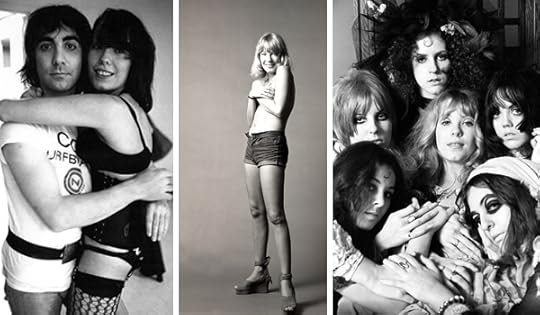
The GTOs were only active for two (1968-1970); their only album, Permanent Damage, produced by Zappa, was released in 1969. Miss Sparky, who sparked Pam's journey, was renowned for driving a Hudson Hornet in the late 1960s along the Sunset Strip. Her story is far more obscure than even Des Barres, and no one has known her whereabouts since early in the new millennium, but let's explore The GTOs in a follow-up post.
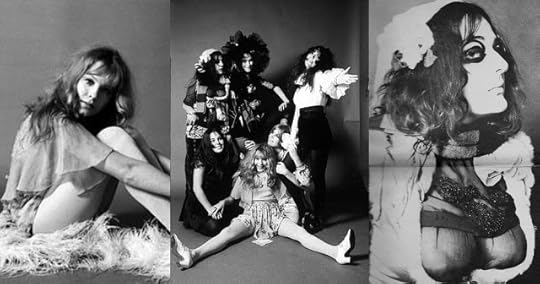
On October 29, 1977 Pamela Miller married Michael Des Barres, but was divorced in 1991. She has kept her married name Pamela Des Barres and has published several memoirs of her experience as a groupie – her word, not mine; despite her "spirited sexuality," and the unknown history of many a song, I'd instead categorize Pamela as the ultimate muse. And I'd go so far as to say rock's greatest first person historian. "I just had to know these guys," she explained. "I wasn't happy just sitting around, looking at a poster of a rock star. I wanted to touch them. When you were a kid growing up in the '60s, rock was incredibly liberating. These guys were sending a message. They had skintight pants and wild guitars and you wanted to be a part of it." While other accounts of the era have painted many rock stars as crude, drug-addled, male-chauvinist jerks, Des Barres insists she never felt exploited or subservient. "I saw myself more as some kind of geisha girl."
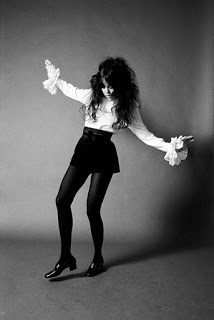 Miss SparkyCriticize her life all you want, but for me, Pamela has led the ultimate charmed life. The stories at AM are 2nd-hand at best, and the result of years of research, and while the stories in
Jay and the Americans
reflect my personal experiences with rock's elite (playing Ouija with David Crosby at The Trip when I was five; hanging out, unintentionally, with Chuck E. Weiss), Pamela was the proverbial fly on the wall. And of course, I've never written a proverb so telling as "Tobacco is my favorite vegetable." What's interesting about her writing is the journalistic style it takes, mostly shying away from any real emotion. Her relationship with Keith Moon, for instance, is there in her biographies, but one might overlook the intensity of their relationship. Research would say otherwise, and photography speaks volumes - there are more pictures of Keith with Pamela than any other icon. It's only with Gram Parsons that Pamela's emotions are at the surface, referring to Parsons, despite their lack of sexuality, as her "soul mate."
Miss SparkyCriticize her life all you want, but for me, Pamela has led the ultimate charmed life. The stories at AM are 2nd-hand at best, and the result of years of research, and while the stories in
Jay and the Americans
reflect my personal experiences with rock's elite (playing Ouija with David Crosby at The Trip when I was five; hanging out, unintentionally, with Chuck E. Weiss), Pamela was the proverbial fly on the wall. And of course, I've never written a proverb so telling as "Tobacco is my favorite vegetable." What's interesting about her writing is the journalistic style it takes, mostly shying away from any real emotion. Her relationship with Keith Moon, for instance, is there in her biographies, but one might overlook the intensity of their relationship. Research would say otherwise, and photography speaks volumes - there are more pictures of Keith with Pamela than any other icon. It's only with Gram Parsons that Pamela's emotions are at the surface, referring to Parsons, despite their lack of sexuality, as her "soul mate." With Keith MoonStill, no resource that I can find is more fascinating than word of mouth: "My most important time with these men, friends and lovers alike, was being onstage with them. As close as you could be to being in the band was to stand on the side of the stage. Keith Moon, when they were doing Tommy, he made me stand on the stage next to the drum kit. It's amazing I can still hear it. He wanted me right there. In Zeppelin's case, Jimmy had me sitting up on the amplifiers, so I could see. Everybody could see me up there, and I could see these girls [in the audience] with so much envy.
With Keith MoonStill, no resource that I can find is more fascinating than word of mouth: "My most important time with these men, friends and lovers alike, was being onstage with them. As close as you could be to being in the band was to stand on the side of the stage. Keith Moon, when they were doing Tommy, he made me stand on the stage next to the drum kit. It's amazing I can still hear it. He wanted me right there. In Zeppelin's case, Jimmy had me sitting up on the amplifiers, so I could see. Everybody could see me up there, and I could see these girls [in the audience] with so much envy."You've gotta remember how young I was. I was 19, 20 years old. Jimmy was 24. We were young people. Your ego wasn't even formed yet, and it was just a heady experience. There were no girl rock bands yet, so it was as close as you could get to being in the band. Being onstage with The Stones, with The Kinks, with The Doors, with The Byrds, with the Mothers, with Zeppelin, The Who. It was incredible."
Published on March 01, 2018 05:13
Frank Zappa and The GTOs
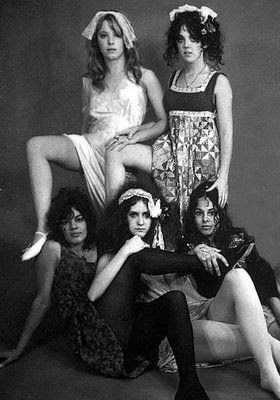 The sixties began boisterously with The Beatles and their "long" hair and their "yeah, yeah yeahs." It was far removed from the crooners and pop stars that had set the standard since the 1930s, but it paled in comparison to what would occur in the second half of the decade as the Fab Four quit touring to hit the studio, the hippie movement emerged in L.A. and San Francisco, and garage rock took over New York.
The sixties began boisterously with The Beatles and their "long" hair and their "yeah, yeah yeahs." It was far removed from the crooners and pop stars that had set the standard since the 1930s, but it paled in comparison to what would occur in the second half of the decade as the Fab Four quit touring to hit the studio, the hippie movement emerged in L.A. and San Francisco, and garage rock took over New York.Dave Marsh would coin the phrase "punk rock" in 1970, a catch phrase for all kinds of garage rock, bubblegum, surf and hot rod music, and iconic bands like The Velvet Underground. In L.A. that kind of heaviness with a touch of the avant-garde was the forte of bands like The Mothers of Invention and Captain Beefheart's Magic Band. Out of that subterranean mix came The GTOs (I know, you’ve never even heard of them, outside the car).
The GTOs were six (sometimes seven) hot girls who were initially groupies from all over L.A.. Several of the girls hung around the Sunset Strip area in the sixties. Groups like The Byrds, The Seeds, The Standells, Love and The Doors were the Strip's house bands. The GTOs were Miss Pamela (Pamela Ann Miller, later Pamela Des Barres), Miss Sparky (Linda Sue Parker), Miss Lucy (Lucy Offeral, later Lucy Mclaren), Miss Christine (Christine Frka), Miss Sandra (Sandra Lynn-Rowe, later Sandra Leano), Miss Mercy Fontenot, aka Judith Edra Peters and Miss Cinderella (Cynthia Wells, later Cynthia Cale-Binion). The band was mentored by Frank Zappa, who of course was a major player in L.A.'s counterculture, AKA "the freaks," and yet, Zappa didn't use any LSD and Marijuana - he thought it interfered with the ability to play music and he expected the musicians who worked for him (the various lineups of the Mothers of Invention) to stay straight while on stage or in the studio, hence his mistrust of hippies.
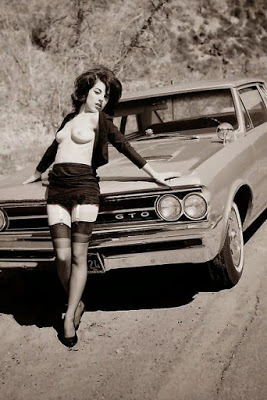 The lineup seemed like something out of the 80s rather than the sixties. Miss Sparky drove a Hudson Hornet attracting loads of attention on the strip when out in her ride with the band, done up in their stage outfits (or lack of them) and makeup. Miss Mercy was from San Francisco and attended a Fillmore concert the first night they opened in 1966. She turned on to acid for the first time that night. She was in and out of Juvenile Hall while in her teens. Miss Christine and Miss Cinderella shared a room at The Landmark Hotel in 1967. They later brought in Miss Mercy (the Landmark Hotel is remembered as the site of Janis Joplin's 1970 death from a drug overdose). Miss Christine had come to L.A. from San Pedro with Miss Sandra where they initially lived in the basement of Zappa's house in the mid-sixties. Miss Christine was the live-in nanny for Zappa's two oldest children (Dweezil and Moon Unit) before Miss Pamela took over the position. Miss Mercy came from Haight-Ashbury, which she left out of boredom, saying she "couldn't be a hippie forever." Miss Cinderella was brought into the group by Miss Mercy later on. Let's see, is that everybody?
The lineup seemed like something out of the 80s rather than the sixties. Miss Sparky drove a Hudson Hornet attracting loads of attention on the strip when out in her ride with the band, done up in their stage outfits (or lack of them) and makeup. Miss Mercy was from San Francisco and attended a Fillmore concert the first night they opened in 1966. She turned on to acid for the first time that night. She was in and out of Juvenile Hall while in her teens. Miss Christine and Miss Cinderella shared a room at The Landmark Hotel in 1967. They later brought in Miss Mercy (the Landmark Hotel is remembered as the site of Janis Joplin's 1970 death from a drug overdose). Miss Christine had come to L.A. from San Pedro with Miss Sandra where they initially lived in the basement of Zappa's house in the mid-sixties. Miss Christine was the live-in nanny for Zappa's two oldest children (Dweezil and Moon Unit) before Miss Pamela took over the position. Miss Mercy came from Haight-Ashbury, which she left out of boredom, saying she "couldn't be a hippie forever." Miss Cinderella was brought into the group by Miss Mercy later on. Let's see, is that everybody?The group originally called itself The Cherry Sisters, and later, The Laurel Canyon Ballet Company, but Zappa persuaded them to change it to The GTOs. GTOs could mean "Girls Together Orally" or "Girls Together Only" or maybe "Girls Together Outrageously," the later the one that sticks on Wikipedia. The girls were also a part of a freeform dance troupe called "Vito and His Freakers" (but that’s a “whole nother story"). They would show up at clubs all over L.A. and if there was music playing they would dance around in a bizarre, sexual way. In a recent interview, Pamela Des Barres said that Vito would actually grab the other dancers and literally throw them about 10 or 15 feet in romantic bravado. These were the "hottest" girls in rock 'n' roll and their fetish-like outfits, made for them at Vito & Szou's Art Studio/Fashion Boutique and Crash Pad, catapulted their celebrity.
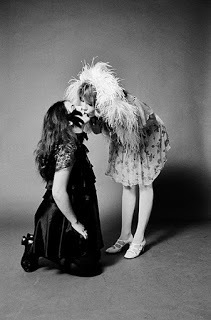 When The Byrds toured the Midwest, one of their roadies, Carl Franzoni, took the girls on the road as "touring Byrds dancers," amidst great fanfare. Franzoni was eventually associated with Frank Zappa - he's the Carl Orestes Franzoni mentioned in the liner notes of the Freak Out album. Franzoni moved the girls into Frank's digs in Laurel Canyon before long. As they began to assemble themselves into a rock and roll band, they developed a style which was campy but oddly disquieting. The performances featured all of the GTO's taking turns singing their strange songs, reciting poetry, doing obtuse and strange dancing in weird costumes. It was a take on Victorian era "see what my daughter can do" tea social, this time around with a touch of the lysergic.
When The Byrds toured the Midwest, one of their roadies, Carl Franzoni, took the girls on the road as "touring Byrds dancers," amidst great fanfare. Franzoni was eventually associated with Frank Zappa - he's the Carl Orestes Franzoni mentioned in the liner notes of the Freak Out album. Franzoni moved the girls into Frank's digs in Laurel Canyon before long. As they began to assemble themselves into a rock and roll band, they developed a style which was campy but oddly disquieting. The performances featured all of the GTO's taking turns singing their strange songs, reciting poetry, doing obtuse and strange dancing in weird costumes. It was a take on Victorian era "see what my daughter can do" tea social, this time around with a touch of the lysergic.Frank was always on the lookout for different and offbeat talent and maneuvered the free-spirited girls to record the 17 song LP album Permanent Damage. Zappa produced the majority of the LP alongside Lowell George (a member of the Mothers and soon to be a founder of Little Feet). Other luminaries such as Ry Cooder, Davy Jones, Jeff Beck, Nicky Hopkins and Rod Stewart also appear on the LP. (Rock ‘n’ Roll mythology points to this aside: At some point Rod Stewart left Zappa’s suburban L.A. studio to wander about in the middle of the night. The GTOs finally went out to look for him. Worried that he was he was from England and he didn't know the turf, they panicked that he could've fallen into a swimming pool or gotten bit by someone's Doberman. As the story goes, they kept calling "Rodney, Rodney" until they finally found him on the steps of a school building moping and pining.)
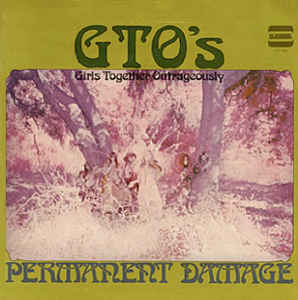 Permanent Damage was released in 1969 with such disreputable titles as (the Zappa touch is obvious):
Permanent Damage was released in 1969 with such disreputable titles as (the Zappa touch is obvious):1. "The Eureka Springs Garbage Lady"
2. "Miss Pamela and Miss Sparky Discuss Stuffed Bras and Some of Their... "
3. "Who's Jim Sox"
4. "Kansas and The BTO's"
5. "The Captain's Fat Theresa Shoes"
6. "Wouldn't It Be Sad if There Were No Cones"
7. "Do Me in Once and I'll Be Sad, Do Me in Twice and I'll Know Better"
8. "The Moche Monster Review"
9. "TV Lives"
10. "Rodney"
11. "I Have a Paintbrush in My Hand to Color a Triangle"
12. "Miss Christine's First Conversation With The Plaster Casters of... “
13. "The Original GTO's"
14. "The Ghost Chained to the Past, Present, and Future (Shock Treatment) "
15. "Love on an Eleven Year Old Level"
16. "Miss Pamela's First Conversation With The Plaster Casters of Chicago"
17. "I'm in Love With The Ooo-Ooo Man GTO's"
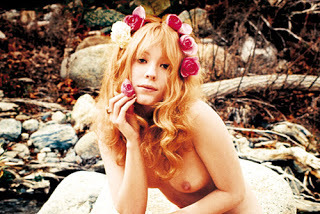 The GTOs' music and stage show, both musically and visually, was intelligently crafted with signature Zappa weirdness. Des Barres says Frank was a genius and he was very good about letting The GTOs exercise creativity and originality. The girls acquired cosmetology school names like "Miss Christine," "Miss Sparky," "Miss Lucy," etc., all compliments of Tiny Tim, the falsetto-voiced ukulele player famous for "Tip Toe Through the Tulips" and for marrying Miss Vickie (not a GTO) on the Tonight Show.
The GTOs' music and stage show, both musically and visually, was intelligently crafted with signature Zappa weirdness. Des Barres says Frank was a genius and he was very good about letting The GTOs exercise creativity and originality. The girls acquired cosmetology school names like "Miss Christine," "Miss Sparky," "Miss Lucy," etc., all compliments of Tiny Tim, the falsetto-voiced ukulele player famous for "Tip Toe Through the Tulips" and for marrying Miss Vickie (not a GTO) on the Tonight Show. Despite the LP, the support of Zappa (and seemingly all of Hollywood), The GTOs only played five gigs in their career, though these were important venues like the Whiskey A Go-Go, with their first major gig was as the opening act for The Mothers in 1968 at L.A.'s Shrine auditorium. Their live sound was marked by slightly dissonant harmonies (similar to the harmonies employed by Frank and The Mothers of Invention) and very tasty keyboard and guitar touches. Despite their celebrity and Zappa's input, The GTOs remain obscure.
Published on March 01, 2018 04:01
February 28, 2018
Zappa on Dylan
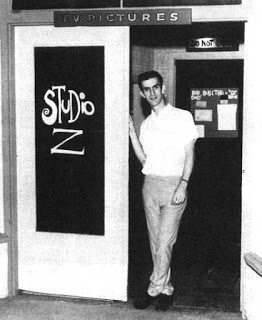 Zappa's Studio Z...Frank Zappa was working in cheesy lounges and go-go bars, the kind of place where too-old chicks in white vinyl boots, women who thought they were Nancy Sinatra, danced to the repetitious beats of nowhere rock bands. L.A. was the home of Jack-in-the-Box and surfers, blonde hair and the plastic age. It was the new America, and while the 60s were simultaneously developing their own consciousness, rock was merging with folk: rock 'n' roll became rock (we've already had this convo). When finally Dylan welded the two firmly into place, much to the chagrin of the folk purist, it became clear that rock with a message was next.
Zappa's Studio Z...Frank Zappa was working in cheesy lounges and go-go bars, the kind of place where too-old chicks in white vinyl boots, women who thought they were Nancy Sinatra, danced to the repetitious beats of nowhere rock bands. L.A. was the home of Jack-in-the-Box and surfers, blonde hair and the plastic age. It was the new America, and while the 60s were simultaneously developing their own consciousness, rock was merging with folk: rock 'n' roll became rock (we've already had this convo). When finally Dylan welded the two firmly into place, much to the chagrin of the folk purist, it became clear that rock with a message was next. Zappa was well aware of Dylan's power too. "Dylan's 'Subterranean Homesick Blues' was a monster record. I heard that thing and I was jumping all over the car. And then when I heard the one after that, 'Like a Rolling Stone,' I wanted to quit the business because I felt that if this wins and does what it's supposed to do, I don't need to do anything. It sold, but nobody responded the way they should have. They should have listened to that and said, 'Hey, that record got on the radio. Now wait a minute, we've got a chance to say something, you know? The radio is for us to use as a weapon.' It didn’t happen right away, and I was a little disappointed. I figured, well shit, maybe it needs a little reinforcing."
Zappa was well aware of Dylan's power too. "Dylan's 'Subterranean Homesick Blues' was a monster record. I heard that thing and I was jumping all over the car. And then when I heard the one after that, 'Like a Rolling Stone,' I wanted to quit the business because I felt that if this wins and does what it's supposed to do, I don't need to do anything. It sold, but nobody responded the way they should have. They should have listened to that and said, 'Hey, that record got on the radio. Now wait a minute, we've got a chance to say something, you know? The radio is for us to use as a weapon.' It didn’t happen right away, and I was a little disappointed. I figured, well shit, maybe it needs a little reinforcing."
Published on February 28, 2018 14:52
Zappa's Canyon
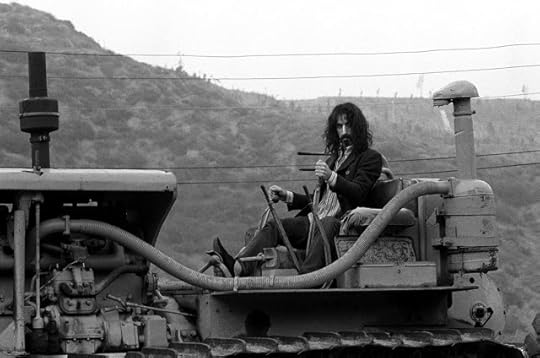 Jim Morrison's swagger didn't fit into the social ghetto that was Laurel Canyon and yet, while his music was by far the more diverse, Frank Zappa was right there in the midst of the enclave, Mike Nesmith at his side, schmoozing with Joni, Mama Cass and all of the Papas.
Jim Morrison's swagger didn't fit into the social ghetto that was Laurel Canyon and yet, while his music was by far the more diverse, Frank Zappa was right there in the midst of the enclave, Mike Nesmith at his side, schmoozing with Joni, Mama Cass and all of the Papas.Frank Zappa and the Mothers of Invention were described as ugly, repulsive, gross, sarcastic, satirical, iconoclastic, and nasty, just the kind of names they liked to be called. They have also been called brilliant, super-talented, inspired, and real. Whatever, the self-taught Zappa was quickly recognized as the country’s most cognizant contemporary musician.
What Zappa and the Mothers said, both musically and verbally, was often belligerent and rebellious, but usually stimulating. They put down The Establishment, parents, high school and prehistoric traditions of morality. They put down the bad guys. It was a philosophy of freaks.
In 1964, Zappa joined The Soul Giants, soon converting them from a bar cover band to performing his original material—they morphed into The Mothers on Mother's Day, 1965. The band was barely able to make a living until impresario Herb Cohen (Pete Seeger, Alice Cooper, Lenny Bruce and Linda Ronstadt) took them on and began booking them at hotspots like Bido Lido's and the Whiskey A-Go-Go. Their debut album, Freak Out!, launched them as The Mothers of Invention. It was only the second double rock album ever released—a groundbreaking mélange of musical genres both innovative and irreverent. That tone continued with their second album, Absolutely Free, along with shows that were part concert, part free-for-all circus with stuffed animals and vegetables.
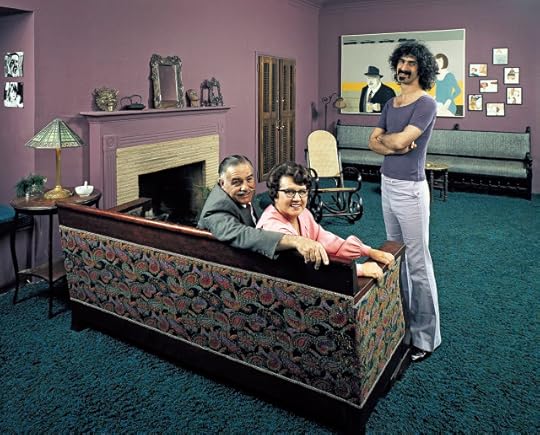 Zappa With His ParentsThough Zappa was regularly a part of the Laurel Canyon scene, what he never embraced was the casual drug use; for Frank, it was all about the music. And yet the scene at Zappa's house, a log cabin he rented for $700 a month, played like an acid clip from a 60s B-movie: Fade in – A car pulls into a driveway of an old log cabin. People are wandering in and out of an enormous 70-foot living room. In the basement, musicians take turns bowling on a Day-Glo painted bowling alley. The adjoining guest house sports a duck pond and two trees growing out of the living room. Couples are huddled in artificial caves built into the hillside. As a couple emerges from the car and into the living room, someone tells the young girl that the cabin was once the house of movie cowboy Tom Mix, and that Harry Houdini used to live across the street. She looks around at the outrageously dressed girls, taking care of a baby named Moon Unit, and the cute young guys playing guitars, and realizes she's inside the epicenter of the Laurel Canyon music scene. It's a scene I'd like to see.
Zappa With His ParentsThough Zappa was regularly a part of the Laurel Canyon scene, what he never embraced was the casual drug use; for Frank, it was all about the music. And yet the scene at Zappa's house, a log cabin he rented for $700 a month, played like an acid clip from a 60s B-movie: Fade in – A car pulls into a driveway of an old log cabin. People are wandering in and out of an enormous 70-foot living room. In the basement, musicians take turns bowling on a Day-Glo painted bowling alley. The adjoining guest house sports a duck pond and two trees growing out of the living room. Couples are huddled in artificial caves built into the hillside. As a couple emerges from the car and into the living room, someone tells the young girl that the cabin was once the house of movie cowboy Tom Mix, and that Harry Houdini used to live across the street. She looks around at the outrageously dressed girls, taking care of a baby named Moon Unit, and the cute young guys playing guitars, and realizes she's inside the epicenter of the Laurel Canyon music scene. It's a scene I'd like to see.That same house entertained a myriad of musicians and celebrities. One house guest was John Mayall, who had just broken up the Bluesbreakers and was taking in the Los Angeles scene. The strange-looking GTO girls made a lasting impression. "Obviously flamboyant comes to mind," Mayall chuckled. "Quite a shock to see for a person visiting from England."
Between guests, Zappa held auditions for his Bizarre and Straight record labels. One band from Phoenix, Alice Cooper, had been turned down by every record company and was going nowhere in a hurry. Fortunately, Cooper was dating Zappa's babysitter, and so Zappa agreed to hear Cooper's band at the cabin "at 7 o’clock." "We were so excited we got there at seven in the morning," said Cooper. "We set up in the living room and started playing our set. Frank came down the stairs with a cup of coffee, and he goes, 'What the hell are you doing?' You said seven. 'Seven at NIGHT.' So he listened to about four songs and he's, 'Okay okay, you're signed, I'll sign you.'"
A young guitarist named Bill Harkleroad, aka Zoot Horn Rollo, showed up at the Cabin to audition for Captain Beefheart, Don Vliet, and found members of the Stones, the Who, the Mothers and a myriad of session musicians roaming about. "Within a few minutes I'm in a jam session with Frank, Don Vliet, Mick Jagger and Art Tripp," said Harkleroad. "Frank and Don were my rock world heroes." He was so nervous he could only play a few notes.
Alice Cooper recalls another Jagger visit, when the Stone showed up inebriated with girlfriend Marianne Faithfull, and the straight-edge Zappa kicked them both out of the house. "I was sitting there, just a kid hanging out to record," said Cooper. "And I went, 'Frank Zappa just threw Mick Jagger out of his house—because he’s drunk.' To me, that's so far in another universe that I couldn’t even believe it."
It was about this time, 1968, when Baron Wolman was asked to photograph Frank. He recalls: "I was worried about going to photograph Frank Zappa. I knew his reputation as a creative eccentric and I was like, 'Oh shit how am I going to deal with this?' Because I didn't even know his music; I mean, of course, I was familiar with his music, he was brilliant. But only if you really knew music could you understand that brilliance; for the most part it wasn't listenable, at least to my ears. Besides, there was nothing I could say to Frank Zappa that would in any way make me an intellectual equal. I knew I could take great pictures but I knew that I couldn't keep up with his mind. We got up there and I said to writer Jerry Hopkins, 'You do the interview first then I'll do the pictures,' but Zappa wanted to do the pictures right away so he and I went out behind his house and found all these bizarre photographic situations that were both wacky and fantastic. I didn't have to say or direct anything; he just started fooling around because he was having such a great time being Frank; Frank being Frank - performing for me and my camera without direction."
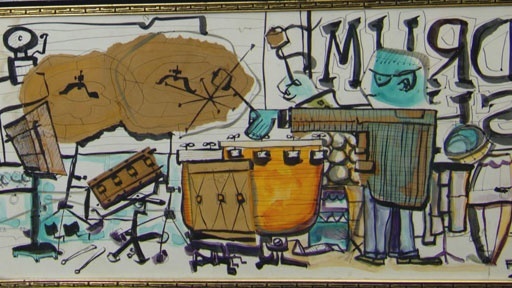 A Piece Found in a Hollywood Junk Store With the Initials F.Z.
A Piece Found in a Hollywood Junk Store With the Initials F.Z.
Published on February 28, 2018 04:29
Help! I'm A Rock - The Mothers of Invention
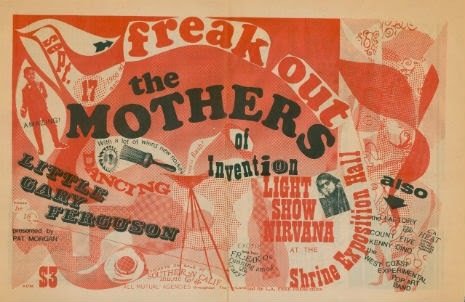 The Doors and The Byrds were Hollywood. As house bands and Strip mainstays, the scene centered on them. One of the bands essential to the L.A. rock scene, and yet not a fixture on the Strip, was The Mothers of Invention. The Mothers got their start instead at Cosmo Alley, one of the most memorable of the Beat era coffee houses. Cosmo Alley was in Hollywood across from the Cinerama Dome and down a back alley near Sunset and Vine. Barbara Dane, a relatively obscure folk and jazz singer, did her tenure there. "It was the epitome of what people imagined a Beat café would be: the waitresses wearing long black tights, long straight hair and lots of eyeliner etc.; lots of poetry and jazz, other experimentation with forms; guys with goatees and berets lurking in dark corners, all of that." The Cosmo, as a coffee house, could stay open later than the bars, so musicians like Ornette Coleman and comedians like Lenny Bruce, hung out after hours. Dane continued, "I got to know Lenny Bruce when he was working in burlesque because he would come in late and after Cosmo Alley was emptied out he'd sit and run his new material by us. Then we'd pass through the back way into an all-night burger joint which had a mynah bird in a cage near the cashier. Lenny persisted in teaching the bird a certain phrase which it finally learned: 'The pope sucks!'"
The Doors and The Byrds were Hollywood. As house bands and Strip mainstays, the scene centered on them. One of the bands essential to the L.A. rock scene, and yet not a fixture on the Strip, was The Mothers of Invention. The Mothers got their start instead at Cosmo Alley, one of the most memorable of the Beat era coffee houses. Cosmo Alley was in Hollywood across from the Cinerama Dome and down a back alley near Sunset and Vine. Barbara Dane, a relatively obscure folk and jazz singer, did her tenure there. "It was the epitome of what people imagined a Beat café would be: the waitresses wearing long black tights, long straight hair and lots of eyeliner etc.; lots of poetry and jazz, other experimentation with forms; guys with goatees and berets lurking in dark corners, all of that." The Cosmo, as a coffee house, could stay open later than the bars, so musicians like Ornette Coleman and comedians like Lenny Bruce, hung out after hours. Dane continued, "I got to know Lenny Bruce when he was working in burlesque because he would come in late and after Cosmo Alley was emptied out he'd sit and run his new material by us. Then we'd pass through the back way into an all-night burger joint which had a mynah bird in a cage near the cashier. Lenny persisted in teaching the bird a certain phrase which it finally learned: 'The pope sucks!'"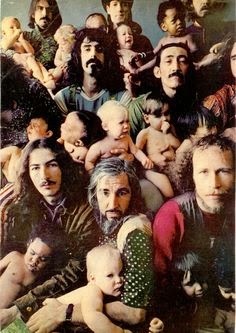 As the era progressed and the Beats were incorporated into the hippie movement, Cosmo Alley, under the management of Herb Cohen (who also managed The Unicorn), began to rely on the teen scene; yet being off the beaten path, artists who played the Cosmo had to have a strong draw. In 1965, Frank Zappa, a would-be film soundtrack composer from Rancho Cucamonga joined rhythm and blues band The Soul Giants. The band was renamed "The Mothers" despite, or because of the inference, and The Mothers started playing in and around L.A. Soon Zappa was the "Freak King" (Freaks were odder, more flamboyant hippie-types, the Oscar Wild(e) hippies, certainly a great draw for the out of the way Cosmo Alley). The Freaks congregated around boho artists Carl Franzoni and Vito Paulekas. "Vito and his Freakers" engaged in open sexual encounters and frequented pop and op art openings and the clubs on the Strip, enlivening each event with their distinctive dancing. According to Sheila Weller in Girls Like Us, "Paulekas and Franzoni trained a young group of 'Freakers' in the sensual body movement that soon became synonymous with mid-1960s dancing. When you walked into Ciro’s in 1965 and heard the music, and saw the stoned dancing, you were jolted by its radical fluidity, gentleness and introspection." In simpler terms, there was a built-in scene for The Mothers.
As the era progressed and the Beats were incorporated into the hippie movement, Cosmo Alley, under the management of Herb Cohen (who also managed The Unicorn), began to rely on the teen scene; yet being off the beaten path, artists who played the Cosmo had to have a strong draw. In 1965, Frank Zappa, a would-be film soundtrack composer from Rancho Cucamonga joined rhythm and blues band The Soul Giants. The band was renamed "The Mothers" despite, or because of the inference, and The Mothers started playing in and around L.A. Soon Zappa was the "Freak King" (Freaks were odder, more flamboyant hippie-types, the Oscar Wild(e) hippies, certainly a great draw for the out of the way Cosmo Alley). The Freaks congregated around boho artists Carl Franzoni and Vito Paulekas. "Vito and his Freakers" engaged in open sexual encounters and frequented pop and op art openings and the clubs on the Strip, enlivening each event with their distinctive dancing. According to Sheila Weller in Girls Like Us, "Paulekas and Franzoni trained a young group of 'Freakers' in the sensual body movement that soon became synonymous with mid-1960s dancing. When you walked into Ciro’s in 1965 and heard the music, and saw the stoned dancing, you were jolted by its radical fluidity, gentleness and introspection." In simpler terms, there was a built-in scene for The Mothers. 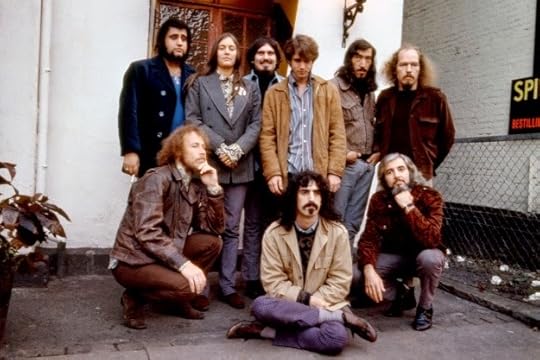
Freak Out! , the 1966 debut album by The Mothers of Invention, was one of the first two-record sets of the rock era (Dylan's Blonde On Blonde beat it by a week). The album wasn't a commercial success, making it only to No. 130 on the Billboard charts, yet it immediately established Frank Zappa in the top rank of rock artists. Freak Out! was produced by legendary African-American record producer Tom Wilson, who also worked with Simon and Garfunkel, The Velvet Underground, Eric Burdon and The Animals and Bob Dylan (Wilson produced three Dylan albums and the “Like a Rolling Stone” single). Wilson signed The Mothers to MGM thinking they were a white blues band, not unlike Big Brother. He'd heard just one song. “Trouble Every Day,” when he saw them at a club on the Sunset Strip and incorrectly assumed the group was something like The Blues Project or MC5. They were anything but. The Mother's inimitable sound was whacked combo of schmaltzy doo-wop, R&B, blues, production gimmicks, free jazz, shifting time signatures, classical music touches and trenchant satirical social observations; indeed, Zappa was rock's ultimate non-conformist.
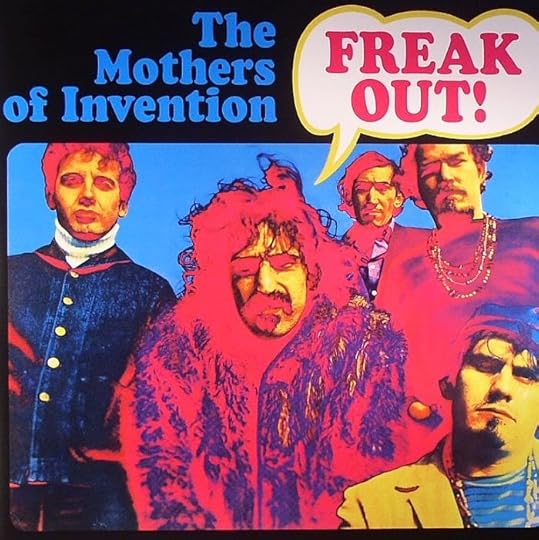 Freak Out! was dropped by MGM in 1970 and left unavailable until Rhino rereleased the set in 1988, leaving the album virtually unknown, even among avid Zappa fans; even among those who would trek out to the midnight theaters in the Valley to watch 200 Motels. Often an album's notoriety and critical acclaim is dictated by availability and marketing; such was the case with Freak Out! and why the album gets no real rubric accolades when it comes to longevity. This will change over time; Freak Out! was revolutionary and evolutionary; we have never danced the same again.
Freak Out! was dropped by MGM in 1970 and left unavailable until Rhino rereleased the set in 1988, leaving the album virtually unknown, even among avid Zappa fans; even among those who would trek out to the midnight theaters in the Valley to watch 200 Motels. Often an album's notoriety and critical acclaim is dictated by availability and marketing; such was the case with Freak Out! and why the album gets no real rubric accolades when it comes to longevity. This will change over time; Freak Out! was revolutionary and evolutionary; we have never danced the same again. According to Suzy Creamcheese of Salt Lake City, Utah: "These Mothers is crazy. You can tell by their clothes. One guy wears beads and they all smell bad. We were gonna get them for a dance after the basketball game but my best pal warned me you can never tell how many will show up…sometimes the guy in the fur coat doesn’t show up and sometimes he does show up only he brings a big bunch of crazy people with him and they dance all over the place. None of the kids at my school like these Mothers…specially since my teacher told us what the words to their songs meant."
When the 2nd Mothers LP was released in 1967, Frank had left L.A. "When it came time for us to do our second album, Absolutely Free, MGM proclaimed that we couldn't spend more than $11,000.00 on it. The recording schedules were ridiculous, making it impossible to perfect anything on the album. It was typical of the kind of bullshit we had to put up with until I got my own studio. Gail and I moved to New York in 1967 to play in the Garrick Theater on Bleecker Street. The first place we stayed, before we could find an apartment, was the Hotel Van Rensselaer on 11th Street. We were living on a small room on one of the upper floors. I was working on the album cover illustration for Absolutely Free at a desk by the window. I remember the place being so dirty I couldn't keep the soot off the artwork."
 Listening to this album is like being locked in a room with a hoard of stand-up comedians - there's no escape. The album takes the form of a couple of wacky narratives or oratarios, as they're described on the sleeve; the first half devoted to vegetables and prunes (which, we are informed, are not vegetables - though pumpkins seem to be). Light on guitar, the LP’s fatal flaw, there is one reprieve in the verbal humor, the instrumental "Invocation and Ritual Dance of the Young Pumpkin". There's some impressive guitar work in this piece that set one on edge for what was yet to come in the Zappa 70s.
Listening to this album is like being locked in a room with a hoard of stand-up comedians - there's no escape. The album takes the form of a couple of wacky narratives or oratarios, as they're described on the sleeve; the first half devoted to vegetables and prunes (which, we are informed, are not vegetables - though pumpkins seem to be). Light on guitar, the LP’s fatal flaw, there is one reprieve in the verbal humor, the instrumental "Invocation and Ritual Dance of the Young Pumpkin". There's some impressive guitar work in this piece that set one on edge for what was yet to come in the Zappa 70s.The second disk is like a Broadway musical, with a mini-musical within. If there's a general theme it escapes me, but there's something about high-school, cream cheese and brown shoes. "Brown Shoes Don't Make It" is the mini-musical within a musical. and plays with numerous musical styles, too many to list, but including crooner, musical, doo wop, blues, 60s R&B, 60s British invasion, jazz, avant garde classical and lounge; the rock base established in Freak Out is sorely missed. The changes between styles often happen at break-neck speed, and the different styles sometimes overlap, all of which adds up to an exhausting listen best enjoyed after a few beers and a J – get through it once and prepare yourself for Joe's Garage. Say what you will, the freak out continues.
Published on February 28, 2018 04:28
February 27, 2018
AM is Now on goodreads

I'm finding that my community of vinyl aficionados (I was going to say "freaks" but it doesn't have the same meaning it did in the Zappa years of L.A. when I was but a boy) while obsessing like me over music, do the same snuggled up in bed with their favorite books. I'm currently in the midst of a new novel called A Piece of the World which uses as its inspiration the Andrew Wyeth painting "Christina's World." It's a fascinating read and I can't wait to discuss it on goodreads.
Because of my new fascination with goodreads, I am posting AM on their site as well, which hopefully will drum up new interest in Jay and the Americans while padding my obsession with lit.
 Join me at goodreads and add me as a friend. I'd love to talk books and music, art and nerdy shit. See you there.
Join me at goodreads and add me as a friend. I'd love to talk books and music, art and nerdy shit. See you there.
Published on February 27, 2018 14:38
Eli and the Thirteenth Confession - Laura Nyro
 Some people don't fit in. Maybe that's why they get overlooked. Paul Simon looked out over the streets of New York and found the beauty in the discordance; John Phillips looked out his second story window in Greenwich Village and packed it in – stopping just long enough to write about all the young girls and their pilgrimage to L.A. Laura Nyro, though, seems lost in Manhattan; she didn't fit, somehow, but she didn’t leave. Out of that we have Eli and the Thirteenth Confession.
Some people don't fit in. Maybe that's why they get overlooked. Paul Simon looked out over the streets of New York and found the beauty in the discordance; John Phillips looked out his second story window in Greenwich Village and packed it in – stopping just long enough to write about all the young girls and their pilgrimage to L.A. Laura Nyro, though, seems lost in Manhattan; she didn't fit, somehow, but she didn’t leave. Out of that we have Eli and the Thirteenth Confession. Nyro was 20 when she recorded her second album. With Columbia offering greater artistic freedom than her previous label, Nyro holed up in the studio, where she stitched together song fragments into a brocade of jazz- and soul-influenced pop music. When she multi-tracks her vocals during more extroverted fare like "Eli's Coming" and "Stoned Soul Picnic," you can picture her, as a teenager, singing in harmony groups on the streets of New York; when the volume dips and the tempo slows, as on "Lonely Woman" and "Boudoir," you can imagine Nyro gazing out over the city in the wee small hours of the morning. While Eli brings something unique and beautiful onto the scene, the album fell on mostly deaf ears, peaking at #189 on the Billboard 200. Nearly thirty years later, Laura Nyro is still woefully unknown to the public, while the potency of her music remains.

Reviewers commonly refer to her music as an amalgamation of Soul, Pop, Jazz, Broadway, and whatever else, but these styles are so seamlessly fused into something wonderfully new, that naming the ingredients is merely a distraction. "Sweet Blindness" may sound age-old, but there's never been another drinking song remotely like it (with The Pogues "Christmas in New York" the exception). "Poverty Train" goes to more places, and back again, than any of Bob Dylan and company's songs. And in 1968 a woman ending her album by screaming "love my lovething," come on. Throughout the record,
Her first album (1967) included a few enduring gems despite a disastrous recording session (consider the ebullient "Wedding Bell Blues" or the prescient "And When I Die" - both hits for other artists. Indeed, Laura was considering an offer to become lead singer for Blood, Sweat and Tears after Al Kooper's split, but was dissuaded by her new manager and close partner David Geffen. How crazy would that have been?).
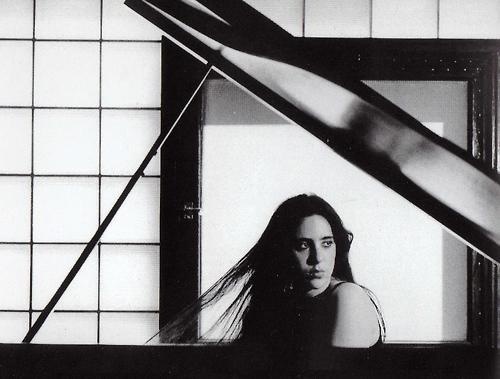
Eli, released Feb 15, 1968, had a perfumed lyric sheet insert (at a time when lyrics were rarely included). While the LP is all but forgotten today, it made her a cult heroine upon its release. That's no small achievement, considering it was competing for attention with The White Album, Beggar's Banquet, Astral Weeks Music from Big Pink, Bookends, Notorious Byrd Brothers, Cheap Thrills and Child is Father to the Man; it takes a back seat to not one of them.
Joni Mitchell owes Laura a great debt. The influence on Rickie Lee Jones can't be overstated. She's been praised most highly, and her impact acknowledged by the likes of Elvis Costello, Elton John and Bob Dylan (who reportedly went up to her at a party and said "I love your chords"). Alvin Ailey has to date choreographed five dances to her music.
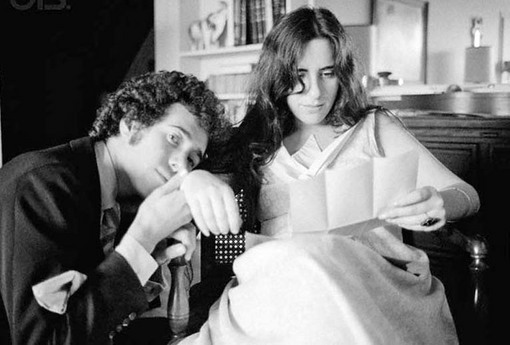 With David Geffen
With David GeffenIn recent years, Laura has been widely promoted as a lesbian voice. Well, that's fine, I suppose. Interpreting a song such as "Emmie" ("You were my friend, and I loved you") as a Sapphic statement creatively rewrites history, though I'm not passionate about any music or musician because of his/her/ sexual predilections, only to the music that comes out of it (I say that and yet, while I adore the awkward brilliance of Anthony and the Johnsons, I come away with less when I listen to Anohni - is that a hidden bias, or is some of the passion gone? I don’t know.)
It's more about her words: There’s an avenue of Devil who believe in stone, Walking on God's good side. A little magic, a little kindness. God is a jigsaw timer. Time and wine, red yellow honey sassafras and moonshine. The natural snow, the unstudied sea, a cameo. Super ride inside my lovething. Or insisting that she "Ain't gonna tell you what I've been drinking," but then she does just that. The entire gallery of experiences of an eccentric, passionate, spiritual, loving person is set on the table with the silverware. She embraces her lover like a god, her God like a lover. Eli is a trip and a half.
Published on February 27, 2018 04:15
February 26, 2018
Bookends
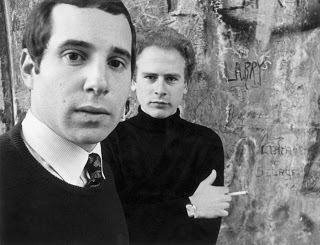 Irish poet William Butler Yeats wrote short, seamless poetry that was nothing but effortless; so it seemed. Yeats, in reality, struggled with revision after revision to create his work. That's the way that Simon and Garfunkel's Bookends may seem, a seamless, effortless masterpiece; a masterpiece, yes, effortless, far from it. Work began on the project in mid 1967 in a bit of a piecemeal fashion that included previously unreleased songs, leftovers from The Graduate soundtrack and a mish-mosh of what didn't seem worth the effort; Paul Simon seemingly lost in the struggle, and yet, by late in the year, the Summer of Love in everyone's rear view, the pieces started to come together. What would emerge was by far Simon and Garfunkel's greatest achievement, as well as one of the greatest LPs ever made.
Irish poet William Butler Yeats wrote short, seamless poetry that was nothing but effortless; so it seemed. Yeats, in reality, struggled with revision after revision to create his work. That's the way that Simon and Garfunkel's Bookends may seem, a seamless, effortless masterpiece; a masterpiece, yes, effortless, far from it. Work began on the project in mid 1967 in a bit of a piecemeal fashion that included previously unreleased songs, leftovers from The Graduate soundtrack and a mish-mosh of what didn't seem worth the effort; Paul Simon seemingly lost in the struggle, and yet, by late in the year, the Summer of Love in everyone's rear view, the pieces started to come together. What would emerge was by far Simon and Garfunkel's greatest achievement, as well as one of the greatest LPs ever made.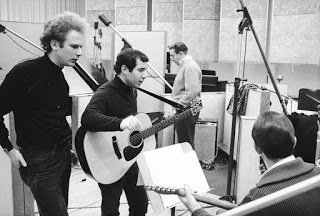 Side One is a concept piece on the subject of aging that kicks off with a thirty-second instrumental snippet of the title track. The full-length vocal arrangement of the song appears at the end of the same side, the two versions serving as, indeed, bookends. The instrumental opening serves as a nice way to ease into the creepy synthesizer-laden intro of "Save the Life of My Child," captured like a developing Polaroid: a young boy is balanced precariously on the ledge of building ready to take his own life or possibly to fly away. Psychedelically produced with multi-layers of dialog and vocal exercises, the song deconstructs itself and segues into the road weary opening hums of "America," one of the greatest songs by anyone, ever, inarguable. "America" is a dusty pastiche of a scrapbook that couldn't be told better in any other medium. Acoustic guitars slightly chorused shimmer under Paul and Art's blended singular voice. A whistling organ breezes in, punctuated by kettle drum, the song rises and falls dynamically with the emotion of the lyrics. "Kathy, I'm lost I said, though I knew she was sleeping, I'm empty and aching and I don't know why," blossom into a glorious emotional peak that defies analysis. Phew. From there, it's a natural transition into the equally weary "Overs," a meditation on a crumbling marriage. The next track, "Voices of Old People" is actually nothing more than a series of field recordings (made by Art Garfunkel) at retirement homes that fittingly fades into the chillingly beautiful ballad "Old Friends," one of Simon’s prettiest melodies. "Old Friends" in turn fades into the full-length version of the title track. The songs go so perfectly together that most hits compilations by the duo that include "Old Friends" also include "Bookends" immediately afterwards (or even link the two together as a single track.)
Side One is a concept piece on the subject of aging that kicks off with a thirty-second instrumental snippet of the title track. The full-length vocal arrangement of the song appears at the end of the same side, the two versions serving as, indeed, bookends. The instrumental opening serves as a nice way to ease into the creepy synthesizer-laden intro of "Save the Life of My Child," captured like a developing Polaroid: a young boy is balanced precariously on the ledge of building ready to take his own life or possibly to fly away. Psychedelically produced with multi-layers of dialog and vocal exercises, the song deconstructs itself and segues into the road weary opening hums of "America," one of the greatest songs by anyone, ever, inarguable. "America" is a dusty pastiche of a scrapbook that couldn't be told better in any other medium. Acoustic guitars slightly chorused shimmer under Paul and Art's blended singular voice. A whistling organ breezes in, punctuated by kettle drum, the song rises and falls dynamically with the emotion of the lyrics. "Kathy, I'm lost I said, though I knew she was sleeping, I'm empty and aching and I don't know why," blossom into a glorious emotional peak that defies analysis. Phew. From there, it's a natural transition into the equally weary "Overs," a meditation on a crumbling marriage. The next track, "Voices of Old People" is actually nothing more than a series of field recordings (made by Art Garfunkel) at retirement homes that fittingly fades into the chillingly beautiful ballad "Old Friends," one of Simon’s prettiest melodies. "Old Friends" in turn fades into the full-length version of the title track. The songs go so perfectly together that most hits compilations by the duo that include "Old Friends" also include "Bookends" immediately afterwards (or even link the two together as a single track.)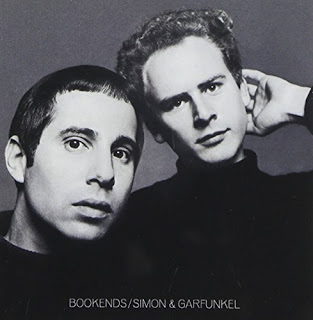 Side Two loses the LPs theme, but in essence, these tracks punctuate what's on Side One, as if Side Two were the OST of Side One, the songs meshing nicely into the album's theme. "Fakin' It," looks back on an earlier life. (Fun trivia: because radio at the time would rarely play anything over three minutes, Paul Simon “faked it” and had the labels for the 45 tweaked to make the song’s 3:15 running time read “2:75” instead.) The Graduate outtake “Punky’s Dilemma” doesn’t fit quite as well lyrically into the rest of the album, but the lighthearted stroll of its music is well-placed in this particular slot on the disc, providing a nice segue into the equally breezy "Mrs. Robinson," the duo’s biggest hit."A Hazy Shade of Winter," previously a non-LP single from 1966, follows. Lyrically, it’s a perfect fit for the concept, and the song’s driving tempo and ironically aggressive acoustic-guitar riff help provide a nice kick after the lazy vibe of the prior two cuts. Brilliantly, there is no extended pause separating the breathless ending of the song from the opening notes of the album's closer, the sweeping "At the Zoo," itself a non-LP single from 1967.
Side Two loses the LPs theme, but in essence, these tracks punctuate what's on Side One, as if Side Two were the OST of Side One, the songs meshing nicely into the album's theme. "Fakin' It," looks back on an earlier life. (Fun trivia: because radio at the time would rarely play anything over three minutes, Paul Simon “faked it” and had the labels for the 45 tweaked to make the song’s 3:15 running time read “2:75” instead.) The Graduate outtake “Punky’s Dilemma” doesn’t fit quite as well lyrically into the rest of the album, but the lighthearted stroll of its music is well-placed in this particular slot on the disc, providing a nice segue into the equally breezy "Mrs. Robinson," the duo’s biggest hit."A Hazy Shade of Winter," previously a non-LP single from 1966, follows. Lyrically, it’s a perfect fit for the concept, and the song’s driving tempo and ironically aggressive acoustic-guitar riff help provide a nice kick after the lazy vibe of the prior two cuts. Brilliantly, there is no extended pause separating the breathless ending of the song from the opening notes of the album's closer, the sweeping "At the Zoo," itself a non-LP single from 1967. Experimental and impeccably produced, Bookends is the duo's best album. The songwriting is flawless, the album's flow is perfect and the experiments have aged very well. Paul Simon has done lots of great and innovative things as a solo artist, but more than 50 years into his career, this remains his finest achievement.
Published on February 26, 2018 05:07
Time It Was and What a Time It Was, It Was
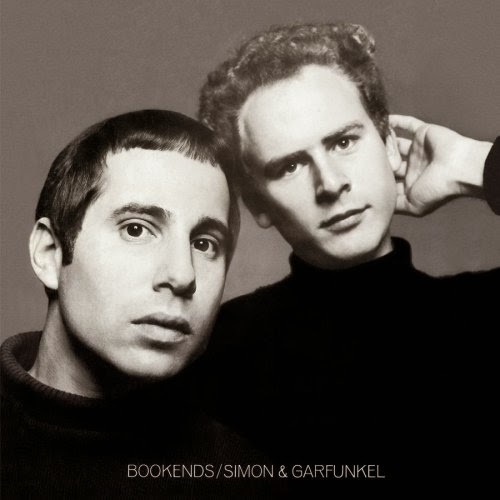 Cover by Richard AvedonBookends (AM9)Artist: Simon and GarfunkelProduced by: Simon and Garfunkel, Roy HaleeReleased: April 3, 1968Length: 29:51Tracks: 1) Bookends Theme (:32); 2) Save the Life of My Child (2:49); 3) America (3:34) 4) Overs (2:14); 5) Voices of Old People (2:07); 6) Bookends Theme (1:16) 7) Fakin' It (3:14); 8) Punky's Dilemma (2:10); 9) Mrs. Robinson (4:02); 10) A Hazy Shade of Winter (2:17); 11) At the Zoo (2:21)Players: Paul Simon - vocals, guitar; Art Garfunkel - vocals, guitar; Hal Blaine - drums, percussion; Joe Osborn - bass; Larry Knecktel - piano, synths
Cover by Richard AvedonBookends (AM9)Artist: Simon and GarfunkelProduced by: Simon and Garfunkel, Roy HaleeReleased: April 3, 1968Length: 29:51Tracks: 1) Bookends Theme (:32); 2) Save the Life of My Child (2:49); 3) America (3:34) 4) Overs (2:14); 5) Voices of Old People (2:07); 6) Bookends Theme (1:16) 7) Fakin' It (3:14); 8) Punky's Dilemma (2:10); 9) Mrs. Robinson (4:02); 10) A Hazy Shade of Winter (2:17); 11) At the Zoo (2:21)Players: Paul Simon - vocals, guitar; Art Garfunkel - vocals, guitar; Hal Blaine - drums, percussion; Joe Osborn - bass; Larry Knecktel - piano, synths Ultimately, and through no fault of its own, Bookends suffers from the fame of half its songs. Tracks like "Mrs. Robinson," "A Hazy Shade of Winter," "America," and "At the Zoo" are so well known that it's hard to view the album as a whole. To the casual listener, the song snippets, experiments and overdubs, so essential to the theme, come across as irritating interludes between hits. While the duo's previous LP (1966's Parsley, Sage, Rosemary & Thyme) showcased both Simon's lyricism and Garfunkel's elegiac vocals, Bookends transcends its predecessor in terms of its subtle ambition. Traditional production values and classic song structure are disavowed by Simon's lithe song writing and Garfunkel's atypical vocal arrangements. Each of the duo's customary roles are intertwined, leaving Bookends their most diplomatic work; most notably Simon's zeugmatic lyrical stream on "Save the Life of My Child" and Garfunkel's beautiful interlude on "Overs;" (arguably the critics' least favorite tracks).
The beauty of the album is overpowering. "America," like The Beach Boys' "God Only Knows" and The Beatles' "The Long and Winding Road" is breathtaking. In Steven Holden's 1972 New York Times review he said: “It is three and a half minutes of sheer brilliance, whose unforced narrative, alternating precise detail with sweeping observation, evokes the panorama of restless, paved America and simultaneously illuminates a drama of shared loneliness on a bus trip with cosmic implications." Yeah, yeah, in simpler terms, it's beautiful; as is "Old Friends," but there instead is the perpetual sadness haunting our mortality.
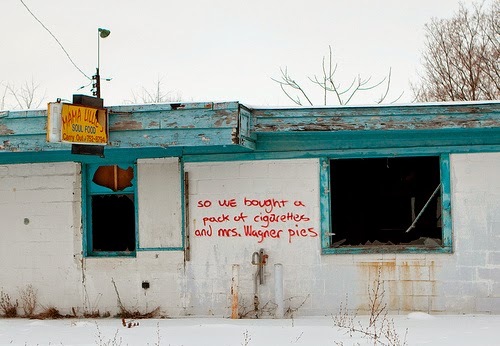 One of many Saganaw buildings with "America" graffitti.Themes of age and aging pervade the record with tracks calling into question many sacrosanct inter-generational ideals, yet failing to provide any answers. Like life, Bookends can be frustrating, yet it is those tracks that most readily take this ambiguous stance, which are the most beloved in Simon and Garfunkel's canon (the hits listed above plus “Old Friends/Bookends) . For much of its overt seriousness and underlying caveat however, there is still an infectious sense of exuberance to Bookends ("Fakin' It" and "Punky's Dilemma"), and it takes a heart of stone not to reminisce "At the Zoo." Simon and Garfunkel are folk music's most acclaimed duo and as such the albums before and after Bookends are often perceived as their finest. In AM terms, Bookends is the top dog, an album that transcends the folk hashtag; only the brevity of the album and experimentation that doesn't quite work keep the album from being an AM10.
One of many Saganaw buildings with "America" graffitti.Themes of age and aging pervade the record with tracks calling into question many sacrosanct inter-generational ideals, yet failing to provide any answers. Like life, Bookends can be frustrating, yet it is those tracks that most readily take this ambiguous stance, which are the most beloved in Simon and Garfunkel's canon (the hits listed above plus “Old Friends/Bookends) . For much of its overt seriousness and underlying caveat however, there is still an infectious sense of exuberance to Bookends ("Fakin' It" and "Punky's Dilemma"), and it takes a heart of stone not to reminisce "At the Zoo." Simon and Garfunkel are folk music's most acclaimed duo and as such the albums before and after Bookends are often perceived as their finest. In AM terms, Bookends is the top dog, an album that transcends the folk hashtag; only the brevity of the album and experimentation that doesn't quite work keep the album from being an AM10.
Published on February 26, 2018 05:07



